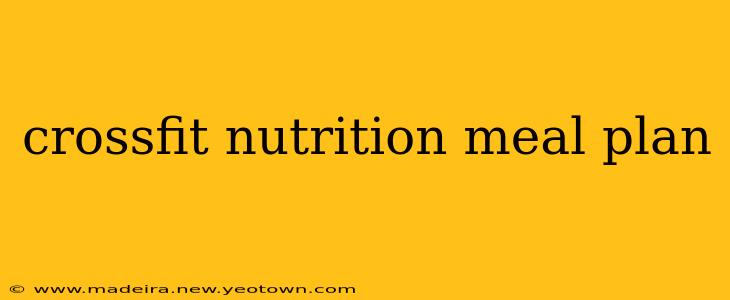CrossFit, with its high-intensity workouts and demanding movements, requires a carefully planned nutritional strategy. It's not just about eating enough; it's about eating the right things at the right times to optimize performance, recovery, and overall well-being. This isn't a one-size-fits-all solution, but a framework to build your personalized CrossFit nutrition meal plan. Think of it as a roadmap, guiding you to fuel your body like a champion.
My name is Alex, and I've been a CrossFit athlete for over 8 years. I've learned firsthand the importance of proper nutrition, both for smashing PRs and feeling fantastic. I'm not a registered dietitian, but this plan reflects my experiences and knowledge, gathered from years of personal experimentation and research.
What are the Macronutrient Needs for CrossFitters?
This is often the first question that pops up, and rightfully so! Your macro needs depend on factors like your training volume, body composition goals, and individual metabolism. A general guideline, however, focuses on a balance:
-
Protein: Aim for 1.6-2.2 grams of protein per kilogram of body weight. Protein is crucial for muscle repair and growth, which is essential after intense CrossFit workouts. Good sources include lean meats, poultry, fish, eggs, Greek yogurt, and legumes.
-
Carbohydrates: Carbs are your primary energy source. The amount you need depends heavily on your training intensity and duration. Prioritize complex carbohydrates like whole grains, fruits, vegetables, and sweet potatoes. These provide sustained energy, unlike simple sugars which lead to energy crashes.
-
Fats: Healthy fats are important for hormone production and overall health. Include sources like avocados, nuts, seeds, olive oil, and fatty fish.
What Should I Eat Before a CrossFit WOD?
Timing is key. You need energy without feeling sluggish.
1-3 hours before:
A balanced meal with complex carbohydrates and some protein is ideal. Think oatmeal with berries and nuts, a whole-wheat toast with avocado and a fried egg, or a chicken salad sandwich on whole-grain bread. Avoid anything too heavy or greasy that might upset your stomach during the workout.
30-60 minutes before:
A lighter snack is better here, focusing on easily digestible carbohydrates. A banana, a small handful of trail mix, or a rice cake with peanut butter can provide a quick energy boost without weighing you down.
What Should I Eat After a CrossFit WOD?
The post-workout window is critical for recovery and muscle protein synthesis.
Within 30 minutes:
This is your priority window for replenishing glycogen stores and starting the muscle repair process. A protein shake with some carbohydrates (like fruit or a banana) is excellent. Consider a combination of fast-digesting and slow-digesting proteins, like whey and casein.
1-2 hours later:
Focus on a meal that provides a larger amount of protein and carbohydrates. This could be a chicken breast with sweet potato and broccoli, or a lean beef stir-fry with brown rice.
What are Some Sample CrossFit Meal Plans?
I can't provide a specific meal plan without knowing your individual needs, but here are a few examples to illustrate the principles:
Sample Meal 1 (High-Volume Training Day):
- Breakfast (7:00 AM): Oatmeal with berries, nuts, and a scoop of protein powder.
- Pre-Workout Snack (11:00 AM): Banana with almond butter.
- Post-Workout (1:00 PM): Protein shake with banana and berries, followed by grilled chicken salad with quinoa.
- Dinner (7:00 PM): Salmon with roasted vegetables and brown rice.
Sample Meal 2 (Low-Volume Training Day):
- Breakfast (8:00 AM): Scrambled eggs with whole-wheat toast and avocado.
- Lunch (12:00 PM): Leftovers from dinner (chicken and vegetables).
- Pre-Workout Snack (4:00 PM): Apple slices with peanut butter.
- Dinner (8:00 PM): Lean ground turkey with sweet potatoes and green beans.
What Supplements Should I Consider?
Supplements should be viewed as supplements, not replacements for a balanced diet. Consider these only after consulting a healthcare professional:
- Creatine: Can improve strength and power output.
- Protein Powder: Convenient for supplementing protein intake.
- Fish Oil: Provides omega-3 fatty acids for overall health.
How Can I Track My Progress and Adjust My Plan?
Tracking your food intake and how you feel during and after workouts is crucial. You might find a food journal or a nutrition tracking app helpful. Observe your energy levels, recovery time, and performance. Adjust your macronutrient ratios based on your progress. Remember, consistency is key!
This is just a starting point. Experiment, find what works best for you, and don't be afraid to adjust your plan as needed. Remember to consult with a registered dietitian or your doctor for personalized advice tailored to your specific needs and goals. Good luck, and happy lifting!

